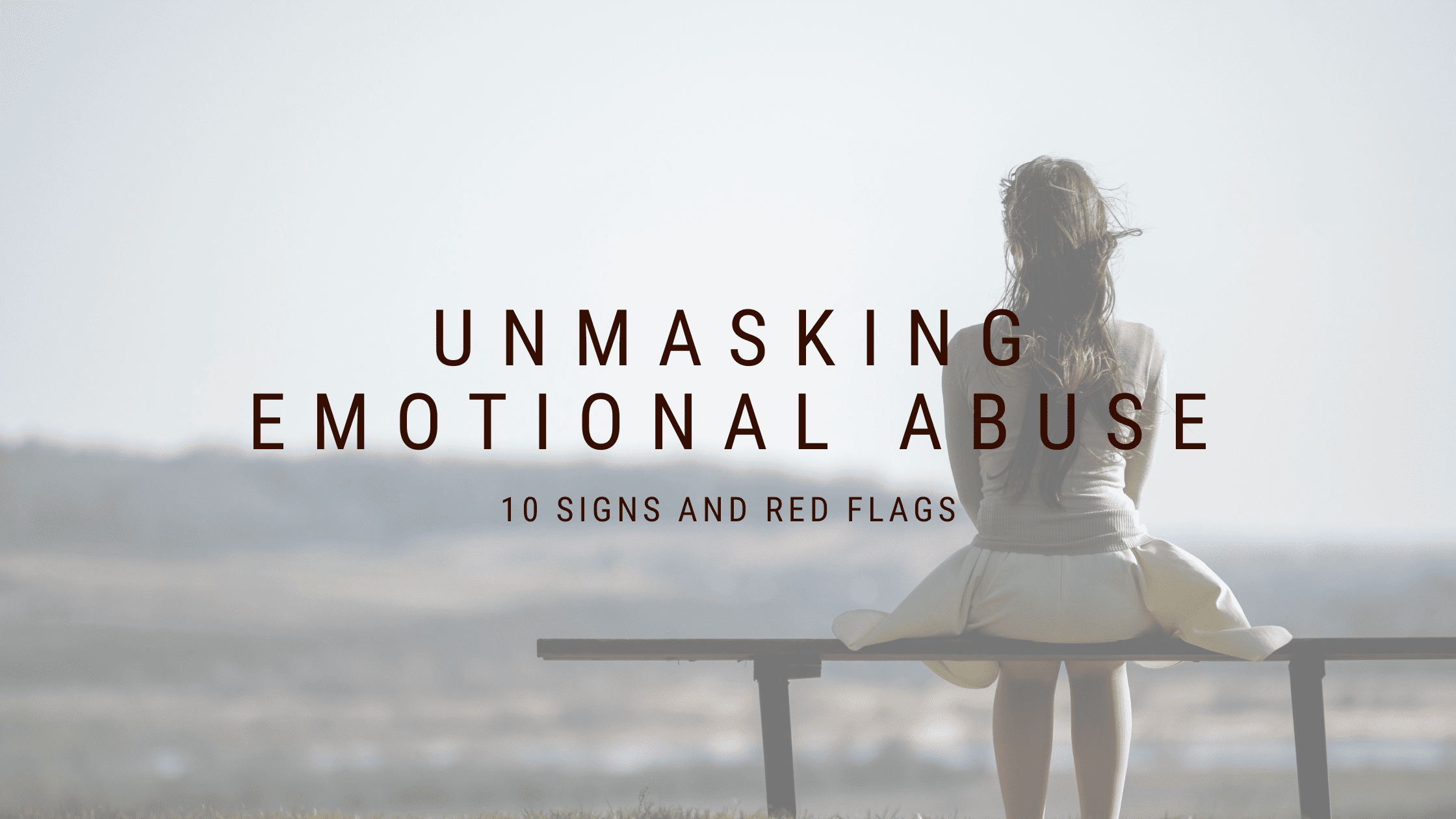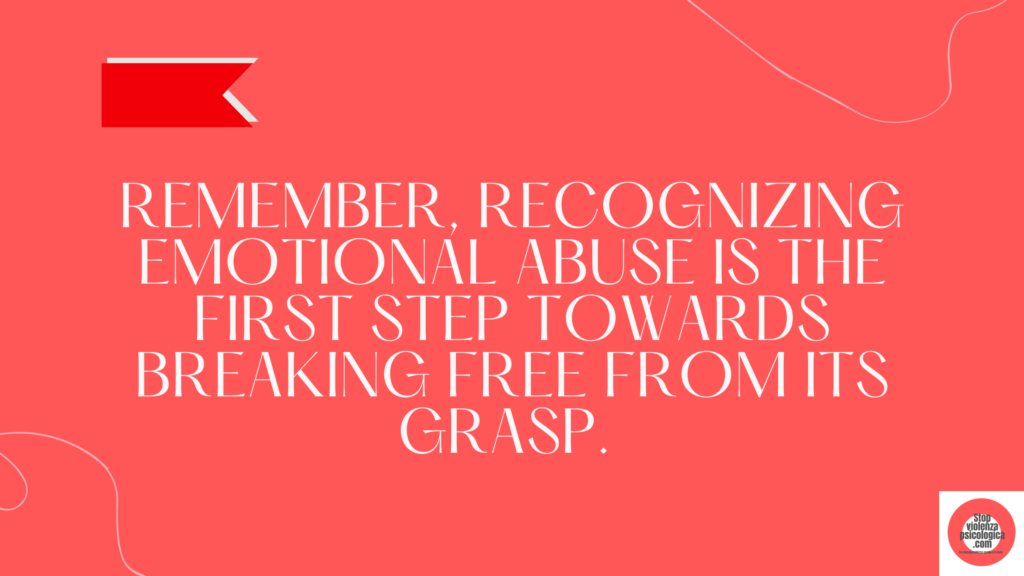Unmasking the Unseen: How to Recognize Emotional Abuse – 10 Signs and Red Flags

This article aims to shed light on how to recognize emotional abuse by highlighting key signs and red flags that may indicate its presence.
In the realm of interpersonal relationships, emotional abuse can often lurk beneath the surface, causing profound harm without leaving visible scars. It is imperative that we develop the ability to recognize the signs and red flags of emotional abuse, as doing so can help protect ourselves and those around us from enduring its devastating effects.
What Is Emotional Abuse?
Emotional abuse, also known as psychological abuse, is a form of mistreatment that targets a person’s emotions, self-esteem, and overall well-being. Unlike physical abuse, which leaves visible marks, emotional abuse inflicts deep wounds on an individual’s mental and emotional state. The impact can be long-lasting and significantly disrupt one’s sense of self.
Recognizing psychological abuse can be challenging because it often occurs behind closed doors and lacks visible evidence. However, being aware of common signs and red flags can help identify potential instances of psychological abuse.
These signs may manifest themselves in various ways, often subtly, making them easy to overlook or dismiss. However, by learning to identify these signs, we can take crucial steps towards intervention and support.
Red flags of emotional abuse may include manipulative behaviors, such as gaslighting, where the abuser distorts the victim’s perception of reality. This may involve denying their experiences or making them question their own sanity.
Additionally, emotional abusers may engage in constant criticism, belittling, or humiliation, systematically eroding the victim’s self-esteem.
Isolation is another prominent red flag. Emotional abusers often seek to isolate their victims from their support networks, whether by controlling their access to friends and family, discouraging social interactions, or creating dependency on the abuser. This isolation reinforces the abuser’s control and diminishes the victim’s sense of independence.
Power and control tactics are core elements of emotional abuse.
Abusers may exhibit excessive jealousy or possessiveness, attempting to exert dominance over every aspect of the victim’s life.
They may use intimidation, threats, or coercion to manipulate and control their partner or loved one. These behaviors are clear indicators of an unhealthy and potentially abusive dynamic.

By honing our understanding of the signs and red flags, we can create a safer, more supportive environment for ourselves and those around us, fostering healthier relationships built on trust, respect, and compassion.
Here are some indicators to look out for.
How to Recognize Emotional Abuse – 10 Signs and Red Flags of Emotional Abuse:
#1 Constant Criticism:
This form of abuse involves the persistent belittling, demeaning, and devaluing of an individual, eroding their self-esteem, and causing significant emotional harm.
The abuser may use derogatory language, ridicule, or demeaning comments to undermine the victim’s self-confidence and create a power imbalance in the relationship.
Over time, repeated exposure to criticism chips away at the victim’s sense of self-worth, leaving them feeling inadequate, ashamed, and insecure.
Furthermore, constant criticism can isolate the victim. The abuser may intentionally undermine the victim’s relationships with others, making them believe they are unworthy of love, support, or validation from anyone else. The victim may withdraw from social interactions, feeling ashamed or embarrassed by the constant criticisms they receive.

#2 Gaslighting:
Gaslighting is a form of psychological manipulation in which the abuser seeks to gain power and control over the victim by distorting their perception of events, emotions, and even their own identity.
The term “gaslighting” originates from the play and subsequent movie adaptation called “Gas Light,” in which a husband systematically manipulates his wife into questioning her sanity by dimming the gas lights in their home and denying that he is responsible.
Here are some common gaslighting phrases abusers may use:
- “You’re overreacting.”
- “That never happened.”
- “You’re just being too sensitive.”
- “You’re remembering it wrong.”
- “You’re making things up.”
- “If you didn’t act that way, I wouldn’t have to treat you like this.”
- “You’re the one causing all the problems.”
- “You’re being irrational.”
- “You’re just imagining things.”, etc.
The impact of gaslighting on the victim is profound and long-lasting.
Over time, the victim may lose confidence in their own perceptions, become overly dependent on the abuser for validation and guidance, and experience feelings of confusion, self-doubt, and anxiety.
Gaslighting can erode the victim’s sense of self-worth, leaving them feeling trapped and powerless.

#3 Control and Domination:
This form of abuse involves exerting power, manipulating, and imposing one’s will over another person, leaving the victim feeling trapped, powerless, and emotionally scarred.
The abuser may use tactics such as intimidation, threats, coercion, isolation, and manipulation to maintain control over the victim. By exerting power, the abuser undermines the victim’s self-esteem and fosters an environment of fear and dependency.
Control and domination in emotional abuse also frequently involve manipulation. The abuser may use tactics such as gaslighting, where they deny or distort the victim’s experiences and make them doubt their own sanity.
They may employ guilt-tripping, blaming, or playing mind games to maintain control and keep the victim emotionally tethered to them.

#4 Isolation:
Isolation is a common tactic used in emotional abuse, aiming to control and manipulate the victim by cutting off their social connections and support systems.
It involves intentionally creating an environment in which the victim feels isolated, alone, and dependent on the abuser.
Isolation can take different forms, ranging from physical separation to emotional and social detachment.
The abuser may restrict the victim’s contact with family, friends, and support networks, isolating them from external influences that could challenge the abuser’s control.
They may discourage or forbid social activities, gaslight the victim into doubting the intentions of others, or use threats and manipulation to enforce isolation.
Furthermore, isolation erodes the victim’s support system, leaving them without external resources or perspectives that could offer a lifeline. Without access to trusted friends, family, or professionals, the victim may struggle to recognize the abuse, question their own experiences, or find the necessary support to escape the abusive situation.

#5 Emotional Manipulation:
One particularly destructive aspect of emotional abuse is emotional manipulation.
This insidious form of abuse involves the intentional exploitation of another person’s emotions, thoughts, and vulnerabilities to gain power and control.
Emotional manipulation occurs when one person uses subtle or overt tactics to manipulate the emotions, beliefs, and behaviors of another individual.
The manipulator may employ tactics such as guilt-tripping, gaslighting, playing mind games, or withholding affection to gain power and control over the victim.
They exploit the victim’s trust, empathy, and desire for love and validation, often leaving them feeling confused, powerless, and doubting their own reality.
The manipulator may use guilt, fear, or shame to coerce the victim into complying with their demands or fulfilling their needs.
They may employ emotional blackmail, leveraging the victim’s love or attachment to control their actions. The victim may feel trapped, constantly seeking the manipulator’s approval and validation, while their own needs and desires are disregarded.
The manipulator may undermine the victim’s relationships with others, strategically creating a dependency on themselves for emotional support and validation. This isolation increases the victim’s vulnerability and makes it more challenging for them to seek help or escape the abusive dynamic.

#6 Threats and Intimidation:
Threats and intimidation occur when one person uses fear, manipulation, and power tactics to control and dominate another.
The abuser may employ explicit threats of harm, violence, or punishment to instill fear and maintain power over the victim.
They may also use subtle forms of intimidation, such as menacing gestures, intense stares, or the destruction of personal belongings, to create an environment of fear and control.
The effects of threats and intimidation can be profound and long-lasting. Victims often experience heightened anxiety, fear, and a constant sense of danger. The pervasive feeling of being on edge and in constant anticipation of the abuser’s next move can have a detrimental impact on their mental and emotional well-being.

#7 Verbal Abuse:
Verbal abuse encompasses a range of behaviors, including name-calling, insults, yelling, screaming, constant criticism, humiliation, and demeaning remarks.
It aims to undermine the victim’s self-worth and manipulate their emotions through the power of words.
Unlike physical abuse, which leaves visible marks, the scars of verbal abuse are often invisible but can be equally, if not more, damaging.
Verbal abuse also serves as a tool for control. The abuser uses words as weapons to manipulate and dominate the victim.
By constantly undermining their confidence and self-esteem, the abuser gains power and maintains control over the victim’s thoughts, emotions, and actions. The victim may feel trapped and unable to assert themselves or speak up for fear of further verbal attacks.

#8 Financial Control:
Financial control occurs when one individual exerts power over another by manipulating their access to money and resources.
The abuser may control the victim’s income, restrict their spending, or demand financial accountability for every penny spent. By exerting control over the victim’s financial decisions, the abuser establishes dominance and undermines the victim’s independence.
In addition to the psychological impact, financial control can create long-term economic instability for the victim. They may be denied access to resources needed to secure housing, education, or employment opportunities, trapping them in a cycle of dependency on the abuser.

#9 Blaming and Shifting Responsibility:
In an emotionally abusive relationship, the abuser consistently avoids taking responsibility for their behaviors and actions. Instead, they employ various strategies to shift the blame onto the victim or external factors. This can include minimizing their actions, denying their involvement, or deflecting blame by pointing fingers elsewhere.
Blaming and shifting responsibility serve to undermine the victim’s sense of self and manipulate their perception of reality. It can lead the victim to doubt their own experiences, question their judgment, and feel responsible for the abuser’s actions.
Over time, the victim may internalize this blame, eroding their self-esteem and reinforcing the power imbalance in the relationship.
Furthermore, blaming and shifting responsibility prevents the abuser from being held accountable for their actions. By consistently placing blame on others, they avoid facing the consequences of their behavior and maintain control over the victim. This dynamic perpetuates the cycle of abuse and hinders the victim’s ability to break free from the toxic relationship.

#10 Constant Monitoring:
Constant monitoring occurs when an individual consistently invades another person’s privacy, scrutinizes their activities, and monitors their every move.
This can take the form of excessive questioning, tracking their whereabouts, monitoring their online activities, reading their messages or emails, or demanding constant updates on their daily life. The abuser uses this monitoring as a means to exert control and maintain power over the victim.
Constant monitoring is a violation of an individual’s autonomy and right to privacy.
It creates a pervasive atmosphere of control, where the victim feels they are constantly being watched, evaluated, and judged. This leads to a profound erosion of their self-esteem, as they are made to believe that their thoughts, actions, and choices are constantly under scrutiny and subject to the abuser’s approval.
Conclusion:
In conclusion, recognizing psychological abuse, particularly emotional abuse, is of utmost importance for the well-being and safety of individuals in relationships.
By being aware of the signs and red flags associated with emotional abuse, we can empower ourselves and others to take action and seek help when needed.
Understanding how to recognize emotional abuse is the first step in addressing the issue.
Look out for red flags such as consistent belittling, criticism, or humiliation from a partner or loved one.
Pay attention to controlling behaviors, such as isolating you from friends and family, monitoring your activities excessively, or demanding constant updates on your whereabouts.
Emotional abuse also often involves manipulation tactics, such as gaslighting, where the abuser distorts reality, causing the victim to question their own perception of events.
Look for patterns of blame-shifting, guilt-tripping, or constantly undermining your feelings and experiences.
Changes in behavior and emotions can also be indicative of emotional abuse.
If you notice a significant shift in your self-esteem, confidence, or overall happiness, it may be a sign that you are experiencing emotional abuse.
Trust your instincts and listen to your feelings when something feels off or uncomfortable in your relationship.
It is essential to remember that emotional abuse can occur in any type of relationship, including romantic, familial, or even professional relationships.
No one deserves to be subjected to emotional abuse, and recognizing the signs is crucial in breaking free from its grip.
If you recognize any of the signs or red flags of emotional abuse in your own life or the lives of those around you, it is essential to take action.
Reach out to trusted friends, family members, or professionals who can offer support and guidance. Educate yourself about resources available for victims of emotional abuse, such as helplines, counseling services, or support groups.
By raising awareness and fostering a culture of understanding, we can help break the cycle of emotional abuse and provide support to those who need it.
Remember, your emotional well-being is valuable, and you deserve to be treated with love, respect, and kindness in all your relationships.
I believe that by sharing our stories and experiences, we can break the silence and raise awareness about emotional abuse. Your voice matters, so please leave a comment below and encourage your friends to join this important conversation. Together, let’s create a safe space where survivors can find support and healing.
Thank you,

Resources:
“The Verbally Abusive Relationship – How to Recognize It and How to Respond”, Patricia Evans
